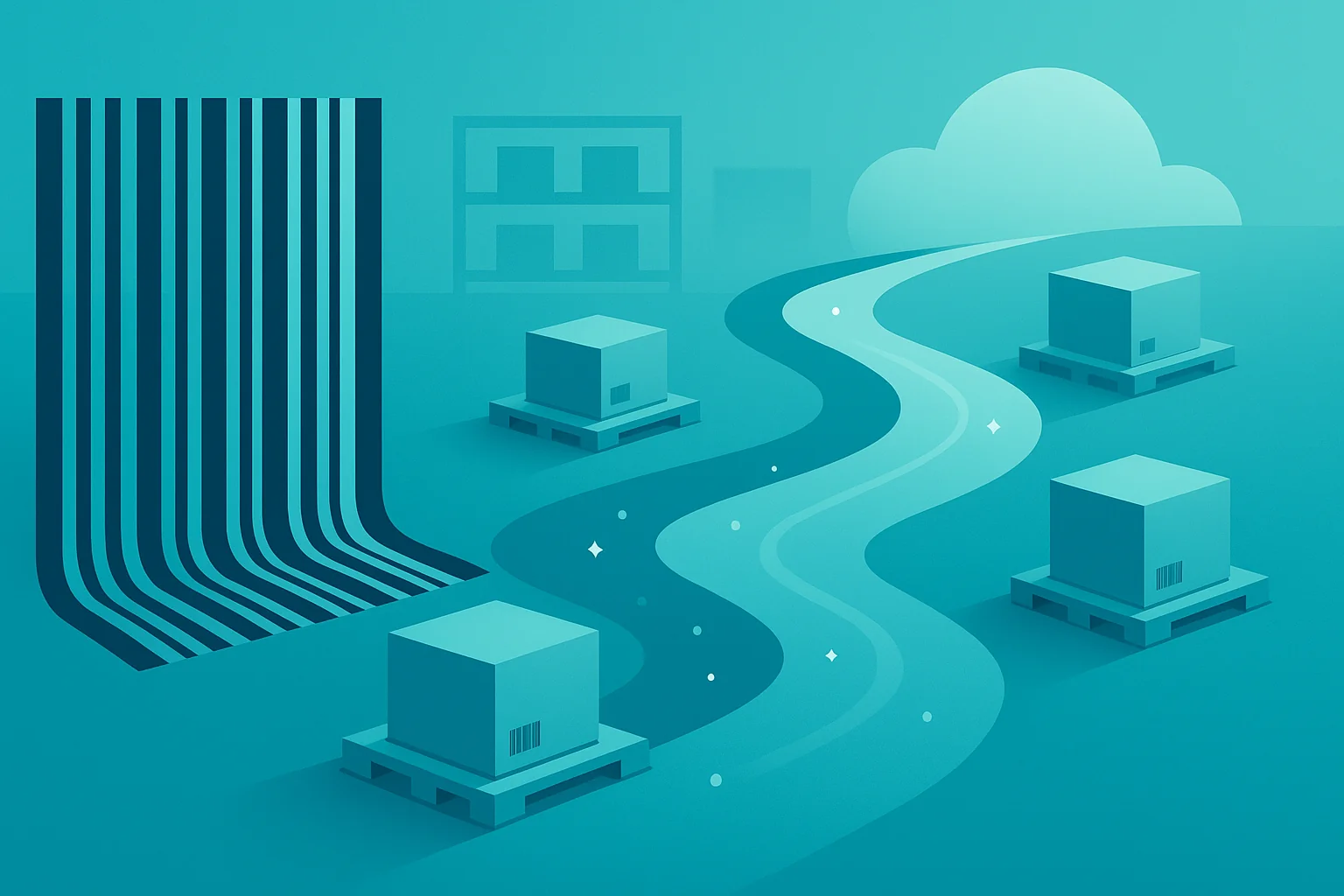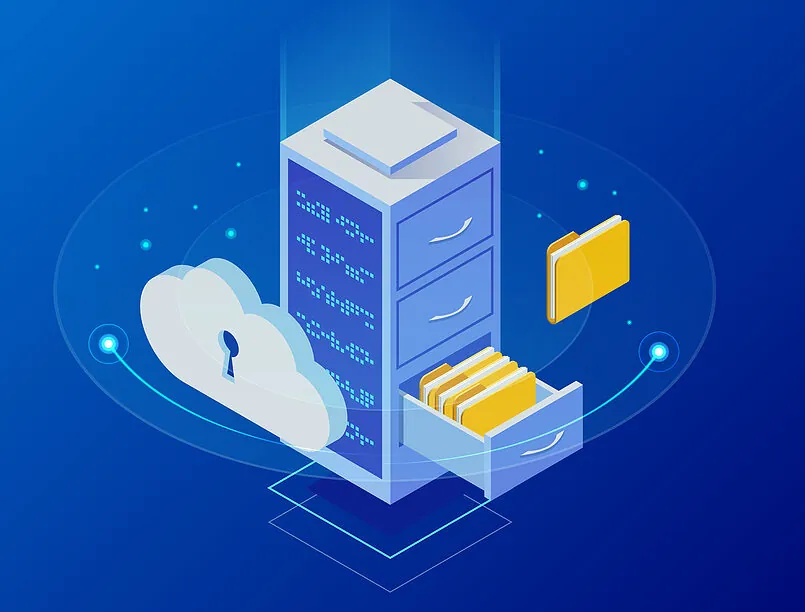
AI Adoption in Supply Chains: From Agents to Mobile Execution
This is part II of the Smarter Supply Chain Series
Part I: Why Supply Chains Need Clean, Real-Time Edge Data for AI Accuracy
Part III: Data Integrity in the Supply Chain: The Hidden Factor Behind AI Accuracy
Part IV: AI Readiness For Supply Chains Starts With Mobile Barcoding
Before we dive into frameworks, let’s play out a relatable scenario. This is the north-star we’re steering toward, and the rest of the article maps the pragmatic path to get there.
It’s mid-week. A planner opens the workbench to a single, ranked alert: a supplier delay that will jeopardize next week’s OTIF unless the team expedites two POs or reallocates stock from DC West. A buyer sees a drafted vendor message with the right PO lines, quantities, and a side-by-side view of cost versus service impact. On the floor, the warehouse lead’s handheld lights up with two tasks already sequenced: pull and relabel the reallocated pallets, then slot the inbound cross-dock to a faster-moving zone. Minutes later, the system of record reflects the change, the promise date holds, and the short-pick risk drops, no war room required.
Nothing in that sequence depends on a rip-and-replace. It relies on your existing ERP to surface reliable signals, a lightweight AI assistant to structure decisions, and mobile execution to turn approvals into scans, moves, labels, and photos. The path we’ll outline is deliberately simple: start in a single high-value domain (like MRP exceptions), wire the key events, let a copilot rank by business impact, route approved actions to handheld tasks, and measure a handful of KPIs so you can prove it worked, then repeat in the next domain.
The State of Supply Chain AI in 2025
Supply-chain AI has moved beyond slideware and into targeted, team-level improvements. Four patterns dominate:
- Forecasting and planning augmentation. Statistical baselines remain, while copilots propose parameter changes, highlight demand signal anomalies, and summarize what changed since the last plan cycle.
- Copilots and assistants in daily work. Think of natural-language helpers embedded in MRP, procurement, and order management that pre-assemble answers, drafts, and transaction stubs.
- Human-in-the-loop agents. These are workflow-aware bots that monitor events (late ASN, short pick, lead-time risk) and prepare actions (expedite, replan, reallocate) for human approval.
- Optimization and orchestration. Network, inventory, slotting, and labor optimization increasingly run as continuous services rather than quarterly projects.
A useful maturity curve you can actually run as a program starts by choosing one flow and making it observable end-to-end: events wired, approvals defined, and the handheld steps mapped. From there, teams progress from analytics + copilots (faster seeing and deciding), to human-in-the-loop agents that monitor and draft actions, and finally to narrowly autonomous moves governed by clear policies and audit trails. At each stage, you widen the slice of process covered and deepen mobile execution, while keeping the same guardrails around roles, approvals, and accountability.
- Stage 1: Analytics + copilots. Get the data right, then help people see and decide faster.
- Stage 2: Agents with human checkpoints. Let software monitor, draft, and queue transactions, while humans approve.
- Stage 3: Policy-governed autonomy. Specific classes of actions execute automatically within well-defined thresholds and audit trails.
None of the above sticks without mobile execution and data capture. If a suggestion does not translate into a scan, a putaway, a cycle-count, or a label printed at the right moment, the value leaks away. That is why mobile workflows (handhelds, scanners, rugged Android/iOS) and offline resilience are not accessories but rather the mechanism that closes the loop.
Reference Architecture: AI + ERP + Mobile, Working as One
Think of a simple, vendor-agnostic stack: an ERP core (SAP, Oracle, Microsoft) remains the system of record for items, suppliers, orders, costs, and inventory, fed by a lightweight data fabric that unifies ERP/WMS/TMS/MES and vendor portals with curated master data and clear lineage. An event bus broadcasts meaningful changes (PO created, ASN delayed, short pick, inventory variance, production scrap) to AI services built from three pieces: LLM-backed copilots for explanations and drafting, agents that watch events and call ERP APIs under policy, and retrieval/vector search that grounds every answer in your documents, policies, and history. An orchestration layer sequences approvals, enforces thresholds, and logs every step, while mobile execution turns decisions into scans, tasks, labels, photos, and offline capture so updates hit the system of record in near real time.
Guardrails: Bake them into the design with role-based access, PII minimization, policy thresholds by role and site, and human sign-off whenever actions fall outside policy. Keep immutable audit logs and wire KPIs to every agent so you can observe drift, trust, and impact over time.
ERP-by-ERP Adoption Paths (What’s Real Today)
We will speak generally to the top ERPs, then dive deeper into three families that pair especially well with mobile data capture and RFgen-style execution: SAP, Oracle (including NetSuite), and Microsoft Dynamics 365. The common thread is to start where data is most reliable, integrate via supported APIs/events, and bind AI suggestions directly to handheld tasks.
SAP S/4HANA & ECC
What to target first:
- MRP exception handling. Copilots summarize exception queues by business impact, cluster repetitive reschedule messages, and suggest parameter tweaks.
- Supplier communications. Agents draft expedite requests with part numbers, quantities, and promised dates pulled from SAP, ready for the buyer’s review.
- Invoice/ASN dispute triage. Natural-language diffs help AP and receiving align on root cause.
- EWM/WM integration. Use SAP’s warehouse events (short picks, over-receipts) as triggers.
- Mobile tie-ins. Cycle-count suggestions flow to scanners as pick-lightstyle tasks. Receiving exceptions spawn photo capture, reason codes, and label reprints.
Integration pattern: BAPIs/OData for transactions, event connectors for inbound triggers, and a mobile layer for guided scanning that respects SAP stock types, HU/SSCC, and bin logic. For native capabilities, teams often start with SAP Business AI as the umbrella for embedded assistance and agent patterns across applications.
Oracle Cloud ERP/SCM & NetSuite
What to target first:
- Planning and sourcing escalation. Agents monitor supply risk and surface PO expedites or re-allocations with cost and OTIF impact.
- Order promising and at-risk orders. Copilots propose alternates or split-ship options and explain tradeoffs in plain language.
- Warehouse exception handling. Short picks trigger replenishment tasks; ASN delays propose cross-dock changes.
- Mobile tie-ins. Handhelds receive receiving, putaway, and pick/pack tasks that reflect agent decisions, capture scans and photos, and update ERP in near real time.
Integration pattern: Use ERP/SCM REST APIs and business events. Keep agent policies visible to business users. Map each suggestion to a mobile task template (receive, move, cycle, relabel). For hands-on context that illustrates agent patterns you can adapt across stacks, many teams look to the content around Oracle AI World as a practical reference point.
Microsoft Dynamics 365 Supply Chain/Finance & Operations
What to target first:
- Demand planning insights. Copilot summarizes forecast deltas, seasonality outliers, and recommends parameter adjustments.
- Procurement insights. Vendor risk signals (late shipments, quality issues) trigger suggested actions and pre-drafted comms.
- Inventory visibility. Agents watch reservations and aging and propose rebalancing across sites.
- Mobile tie-ins. Shop-floor execution, WMS tasks, and field inventory capture run on rugged devices; Power Platform is the glue for approvals and lightweight apps.
Integration pattern: Dataverse and Power Platform for low-code flows; Supply Chain/WMS APIs for transactions; mobile scanning for labels, license plates, and container IDs. For official scenarios and patterns, Microsoft’s documentation on Copilot for Dynamics 365 Supply Chain explains how assistants and summaries slot into day-to-day work.
Acumatica & Sage (X3/Intacct)
Adoption is partner-led. Begin with assistant-style copilots that summarize exceptions and draft communications. Add simple automations with approval (e.g., suggested vendor expediting) and route to mobile tasks for receiving and cycle-count.
Quick Wins by Function (O-SIR Framing)
Below we use an Outcome–Situation–Insight–Recommendation structure to tie pain points to measurable improvements and concrete mobile actions.
Planning
- Outcome: Shorter exception queues, fewer last-minute expedites, higher planner productivity.
- Situation: Planners drown in repetitive reschedules and noisy demand signals.
- Insight: Many exceptions cluster by shared root causes (parameter drift, supplier reliability).
- Recommendation: Use copilots to rank exceptions by business impact and propose simulations (do nothing vs replan vs expedite). Approve the plan, then auto-generate mobile tasks (reallocate, cycle-count to confirm inventory, relabel for cross-dock).
Procurement
- Outcome: Faster supplier recovery, fewer stockouts from late ASNs.
- Situation: Buyers respond ad-hoc to late shipments with manual emails and spreadsheet checks.
- Insight: Lead-time volatility and quality flags are detectable from ERP history and ASN feeds.
- Recommendation: Agents watch risk signals and draft vendor messages with item/qty/date specifics. On approval, create follow-up tasks on handhelds for receiving priorities and inspection sampling tied to the at-risk POs.
Warehouse
- Outcome: Higher pick accuracy, lower travel, better cycle-count effectiveness.
- Situation: Slotting and counting choices are often static or calendar-based.
- Insight: Velocity shifts and exception hot spots should drive where people count and how items are slotted.
- Recommendation: Use AI nudges to propose dynamic slotting and cycle-count selection. Push tasks to scanners with routes, bins, and label templates prefilled. Capture photos for anomalies, and push variance back to agents for learning.
Manufacturing
- Outcome: Fewer material shortages at work centers, higher first-pass yield.
- Situation: Material variances and scrap are noticed late, then reconciled in batch.
- Insight: Real-time capture of issues at the point of work is the cheapest signal to feed quality and planning.
- Recommendation: Mobile quality checks with barcode + photo, lightweight NCR capture, and instant backflush adjustments. Agents propose pacing changes or replenishment moves, which appear as tasks on the line.
Governance, Risk, and Change Management
Governance, risk, and change management start with policy before autonomy: define each agent’s allowable actions, thresholds, and spend limits by role and site. Build explainability into the UI so every suggestion shows why it appeared, the data it used, and the expected impact; keep approvals in context with one-tap mobile sign-offs that include key fields and a link back to the underlying transaction. Preserve immutable audit logs and provide simple rollbacks to reduce risk and accelerate adoption.
Support the frontline with flow-centric training: why a task appeared, how to capture clean scans, and what to do when offline. Then measure trust continuously by watching override rates, false positives, and agent win rate, and use those signals to tune policies, prompts, and guardrails over time.
ROI and KPI Framework
A practical ROI and KPI framework starts with leading indicators you can see within weeks. Track exception aging and planner touch time per exception to gauge decision speed; monitor the percent of exceptions that arrive with a proposed action and buyer cycle time from risk signal to vendor outreach to measure follow-through; and watch warehouse rework and short-pick rates alongside mobile task completion time and first-time scan success to confirm that recommendations are turning into clean execution.
As results accrue, validate business impact with lagging indicators: improvements in inventory turns and working capital, higher OTIF and better promise-date accuracy, reductions in labor hours per order and per line, lower expedite costs and premium freight, and gains in first-pass yield with fewer returns or claims.
30/60/90 plan
- Day 0–30: Pick one domain (e.g., MRP exceptions). Wire events from ERP, stand up a copilot, define policies and thresholds, and build two mobile task templates that reflect agent suggestions. Measure leading indicators.
- Day 31–60: Add a second domain (e.g., at-risk ASNs). Introduce human-in-the-loop agents that draft actions and messages. Expand mobile to receiving and cycle-count. Start a lightweight business case with baseline and trend.
- Day 61–90: Tighten policies and turn on limited autonomy for low-risk actions (e.g., reprint label, trigger count). Share results, then plan the next wave.
Pilot-to-scale checklist
- Named product owner and cross-functional Council
- Approved policies and thresholds documented
- Data lineage and quality checks in place
- Mobile workflows mapped to each agent suggestion
- KPIs and dashboards live, with weekly review
- Runbook for exceptions, outages, and rollbacks
Case Vignettes
Boyd Corporation (Oracle Cloud SCM).
In the Boyd Corporation case study, RFgen Mobile Edge™ preserved critical shop-floor processes during a migration to Oracle Cloud SCM while enabling real-time inventory control and compliant labeling. The takeaway is that always-on data collection that keeps transactions clean and timely. With that foundation, future agents could reliably watch ASN/WIP events and propose targeted expedites or cross-dock moves that land as handheld tasks without creating noise.
The Gill Corporation (SAP).
The Gill Corporation’s SAP story shows how replacing paper with RFgen produced 100% paperless inventory handling, real-time visibility, and in-house configurability. Again, the value is in accurate scans and timestamps reaching SAP instantly. Those signals are exactly what AI assistants would need to cluster MRP exceptions by root cause, confirm with directed cycle-counts on mobile, and recommend small parameter changes with confidence.
National Food Products Company, NFPC (JD Edwards).
In NFPC’s JDE case study, RFgen delivered 99.9% system availability, end-to-end traceability, license-plate labeling, and FEFO-aligned outbound flows across high-volume operations. That level of traceable, structured capture is the ground truth that future AI could leverage (e.g., agents that flag near-expiry risk, adjust pick priorities, or suggest replenishment) because the underlying data is consistent, complete, and tied to handheld execution.
Event references: Oracle AI World sessions
We keep this guide vendor-inclusive, but if you want hands-on depth, the content clustered around Oracle AI World is helpful. The sessions on AI Agents for Fusion SCM, hands-on data intelligence, Agent Studio, and Integration Co-Pilot illustrate how agent designs combine retrieval with business rules and how to connect agent outcomes to execution on the floor; if you plan to attend, you can meet RFgen at Oracle AI World 2025 to see mobile execution patterns in action.
Conclusion and Next Steps
AI adoption in supply chains does not require a rip-and-replace program. Start where signal quality and business value intersect. Bind every AI suggestion to a mobile step that a human will actually perform, with scans, labels, and photos that update the system of record in near real time. Govern with clear policies, measure relentlessly, and expand in waves. That is how teams move from experiments to durable performance gains.
Call to action:
- Run a two-hour readiness assessment focused on one process (MRP exceptions, ASN risk, or warehouse slotting).
- Leave with a 30/60/90 plan, a mapping of agent suggestions to mobile tasks, and a KPI dashboard template.
- Optionally, schedule a workshop to review architecture options and pilot scope with your ERP owner and warehouse leads.







